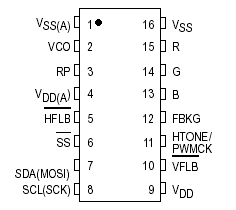Features: • Two Selectable Resolutions: 320 (CGA) and 480 (EGA) Dots per Line
• Fully Programmable Character Array of 10 Rows by 24 Columns
• 273 Bytes Direct Mapping Display RAM Architecture
• Internal PLL Generates a WideRanged System Clock
• For HighEnd Monitor Application, Maximum Horizontal Frequency is 110 kHz (52.8 MHz Dot Clock at 480 Mode)
• Programmable Vertical Height of Character to Meet MultiSync Requirement
• Programmable Vertical and Horizontal Positioning for Display Center
• 120 Characters and Graphic Symbols ROM and Eight Programmable Character RAM
• 10 x 16 Dot Matrix Character
• CharacterbyCharacter Color Selection
• A Maximum of Four Selectable Colors per Row
• Double Character Height and Double Character Width
• Character Bordering or Shadowing
• Three Fully Programmable Background Windows with Overlapping Capability
• Provides a Clock Output Synchronous to the Incoming H Sync for External PWM
• M_BUS (IIC) Interface with Address $7A
• Single Positive 5 V SupplyPinout Specifications
Specifications
|
Symbol |
Characteristic |
Value |
Unit |
|
VDD |
Supply Voltage |
0.3 to + 7.0 |
V
|
|
Vin |
Input Voltage |
VSS 0.3 to VDD + 0.3 |
V |
|
Id |
Current Drain per Pin Excluding VDD and VSS |
25 |
mA |
|
Ta |
Operating Temperature Range |
0 to 85 |
|
|
Tstg |
Storage Temperature Range |
65 to + 150 |
|
NOTE: Maximum Ratings are those values beyond which damage to the device may occur. Functional operation
should be restricted to the limits in the Electrical Characteristics tables or Pin Description section.
This device contains circuitry to protect the inputs against damage due to high static voltages or electric fields; however, it is advised that normal precautions be taken to avoid applications of any voltage higher than the
maximum rated voltages to this high impedance circuit. For proper operation it is recommended that V
in and V
out be constrained to the range V
SS 3 (V
in or V
out) 3 V
DD. Unused inputs must always be tied to an appropriate logic voltage level (e.g., either V
SS or V
DD). Unused outputs must be left open.
DescriptionThe MC141541 is a high performance HCMOS device designed to interface with a microcontroller unit to allow colored symbols or characters to be displayed on a color monitor. The onchip PLL allows both multisystem operation and selfgeneration of system timing. MC141541 also minimizes the MCU's burden through its builtin 273 bytes display/control RAM. By storing a full screen of data and control information, this device has the capability to carry out 'screen refresh' without MCU supervision.
Since there is no spacing between characters, special graphicsoriented characters can be generated by combining two or more character blocks. There are two different resolutions that users can choose. By changing the number of dots per horizontal line to 320 (CGA) or 480 (EGA), smaller characters with higher resolution can be easily achieved.
Special functions of MC141541 such as character bordering or shadowing, multilevel windows, double height and double width, and programmable vertical length of character can also be incorporated. Furthermore, neither massive information update nor extremely high data transmission rate are expected for normal on screen display operation, and serial protocols are implemented in lieu of any parallel formats to achieve minimum pin count.
A special feature, character RAM fonts, is implemented in this MOSD enhanced version (EMOSD). Users can download their own fonts and display them at any time once the chip is powered on. There are two ways for users to build and store fonts. One is a conventional approach to have masked ROM fonts. A newer approach is to store the fonts in the EPROM accessed by the MCU and then download them into the EMOSD character RAM. With this new technique, users have more flexibility in preparing their fonts and the effective number of fonts is greatly increased.

 MC141541 Data Sheet
MC141541 Data Sheet







